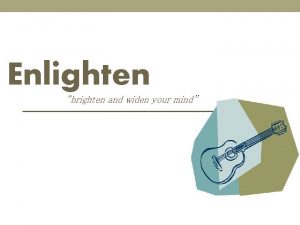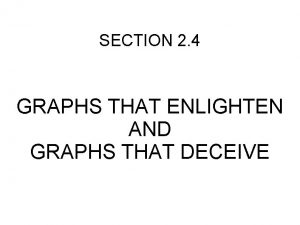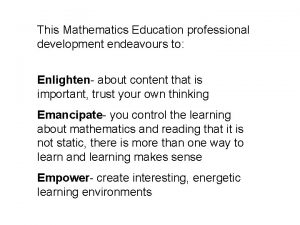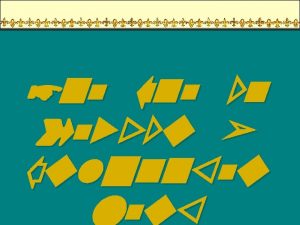2 4 Graphs that Enlighten and Graphs that


















- Slides: 18

2 -4 Graphs that Enlighten and Graphs that Deceive This section discusses other types of statistical graphs. Our objective is to identify a suitable graph for representing the data set. The graph should be effective in revealing the important characteristics of the data.

Key Concept Some graphs are bad in the sense that they contain errors. Some are bad because they are technically correct, but misleading. It is important to develop the ability to recognize bad graphs and identify exactly how they are misleading.

Scatterplot (or Scatter Diagram) A plot of paired (x, y) quantitative data with a horizontal x-axis and a vertical y-axis. Used to determine whethere is a relationship between the two variables. Randomly selected males – the pattern suggests there is a relationship.

Time-Series Graph Data that have been collected at different points in time: time-series data Yearly high values of the Dow Jones Industrial Average

Dotplot Consists of a graph in which each data value is plotted as a point (or dot) along a scale of values. Dots representing equal values are stacked.

Stemplot (or Stem-and-Leaf Plot) represents quantitative data by separating each value into two parts: the stem (such as the leftmost digit) and the leaf (such as the rightmost digit).

Bar Graph Uses bars of equal width to show frequencies of categorical, or qualitative, data. Vertical scale represents frequencies or relative frequencies. Horizontal scale identifies the different categories of qualitative data. A multiple bar graph has two or more sets of bars and is used to compare two or more data sets.

Multiple Bar Graph

Pareto Chart A bar graph for qualitative data, with the bars arranged in descending order according to frequencies

Pie Chart A graph depicting qualitative data as slices of a circle, in which the size of each slice is proportional to frequency count

Frequency Polygon uses line segments connected to points directly above class midpoint values.

Relative Frequency Polygon Uses relative frequencies (proportions or percentages) for the vertical scale.

Ogive A line graph that depicts cumulative frequencies

Graphs That Deceive Nonzero Axis: Graphs can be misleading because one or both of the axes begin at some value other than zero, so that differences are exaggerated.

Pictographs Drawings of objects. Three-dimensional objects - money bags, stacks of coins, army tanks (for army expenditures), people (for population sizes), barrels (for oil production), and houses (for home construction) are commonly used to depict data. These drawings can create false impressions that distort the data. If you double each side of a square, the area does not merely double; it increases by a factor of four; if you double each side of a cube, the volume does not merely double; it increases by a factor of eight. Pictographs using areas and volumes can therefore be very misleading.

Example – Income and Education Bars have same width, too busy, too difficult to understand.

Example – Income and Education Misleading. Depicts one-dimensional data with three-dimensional boxes. Last box is 64 times as large as first box, but income is only 4 times as large.

Example – Income and Education Fair, objective, unencumbered by distracting features.
 Graphs that enlighten and graphs that deceive
Graphs that enlighten and graphs that deceive Purpose to entertain
Purpose to entertain Contra harmonic mean filter
Contra harmonic mean filter Most high and glorious god
Most high and glorious god Ngoại tâm thu thất chùm đôi
Ngoại tâm thu thất chùm đôi Block av độ 2
Block av độ 2 Thơ thất ngôn tứ tuyệt đường luật
Thơ thất ngôn tứ tuyệt đường luật Thơ thất ngôn tứ tuyệt đường luật
Thơ thất ngôn tứ tuyệt đường luật Chiến lược kinh doanh quốc tế của walmart
Chiến lược kinh doanh quốc tế của walmart Tìm độ lớn thật của tam giác abc
Tìm độ lớn thật của tam giác abc Con hãy đưa tay khi thấy người vấp ngã
Con hãy đưa tay khi thấy người vấp ngã Tôn thất thuyết là ai
Tôn thất thuyết là ai Gây tê cơ vuông thắt lưng
Gây tê cơ vuông thắt lưng Sau thất bại ở hồ điển triệt
Sau thất bại ở hồ điển triệt Good state graphs and bad state graphs in software testing
Good state graphs and bad state graphs in software testing Graphs that compare distance and time are called
Graphs that compare distance and time are called Polynomial function form
Polynomial function form Networks and graphs: circuits, paths, and graph structures
Networks and graphs: circuits, paths, and graph structures Tomer owns a daycare
Tomer owns a daycare


































